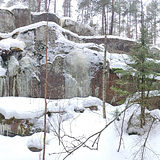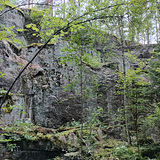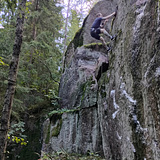The crag is comprised of a huge wall, formed from multiple overlapping sectors ranging from 2-7m in height. The place used to be a Rapakivi-granite quarry, which is the reason for it's unnatural appearance.
The whole crag faces east and is enveloped by trees, so there is a lot of shade and minimal sun. This also means that drying takes ages. Wait for at least 3 days for good conditions here. There are also a LOT of mosquitos here, so bring some bugspray.
Viborgite/rapakivi graniitti itself is usually chossy and does not lend itself for good quality climbing, but due to it being excavated, the rock that is left is decent quality, non eroded viborgite.
The main wall and Alavasen has a similar style of climbing, that being crimpy, technical and mostly vertical with a slab or two mixed in. The main wall is tall, with problems being 4-6,5m tall, with Alavasen being only ~3m tall. Some problems on the main wall require 2+ pads and a spotter.
The Ylävasen wall has some interesting mantling action going on with mostly bad holds. It's about 3-4m tall.
HISTORY OF THE AREA
The area used to be a quarry for viborgite, which is a type of granite. The museum bureau of Finland believes that the quarrying in the area began as early as the late 1700s.
The place has more interesting history though: During the second world war, a Finnish rock salesman by the name of Hugo Blankett travelled to Nazi-germany to pitch the viborgite of the area. Hitler was a fan of this rock, and agreed to buy tonnes of it to gain materials to build their megalomanic architectural plans.
As the war was raging, transporting the rock was impossible. Still, the Germans paid for the rock. After the Germans lost the war, they had to pay war reparations for many countries, one of them being the USSR. Because the Germans had already paid for the rock, it was considered their property and was duly paid out to the USSR, where the rock from this area went towards building the Moscow metro.
This history is the reason the routes have such names. If you open new lines, be sure to stick with the theme.
Quarrying was stopped in the year 1993, after which it was left for nature to reclaim.
MODERN HISTORY
August 2023
The place was scouted by Asikainen, but due to other projects, development was left for later.
February 2024
The topo on 27crags was made, GPS routes were recorded.
August 2024
McGuire & Asikainen brushed up the bulk of the crag, and some routes were sent. A few projects were left unclimbed, mainly the right side dyno of "Sotakorvaus", a variant called "Hugomaniac", the sitstart of "Moskvajoen Silta" and two problems in the Ylävasen sector.



